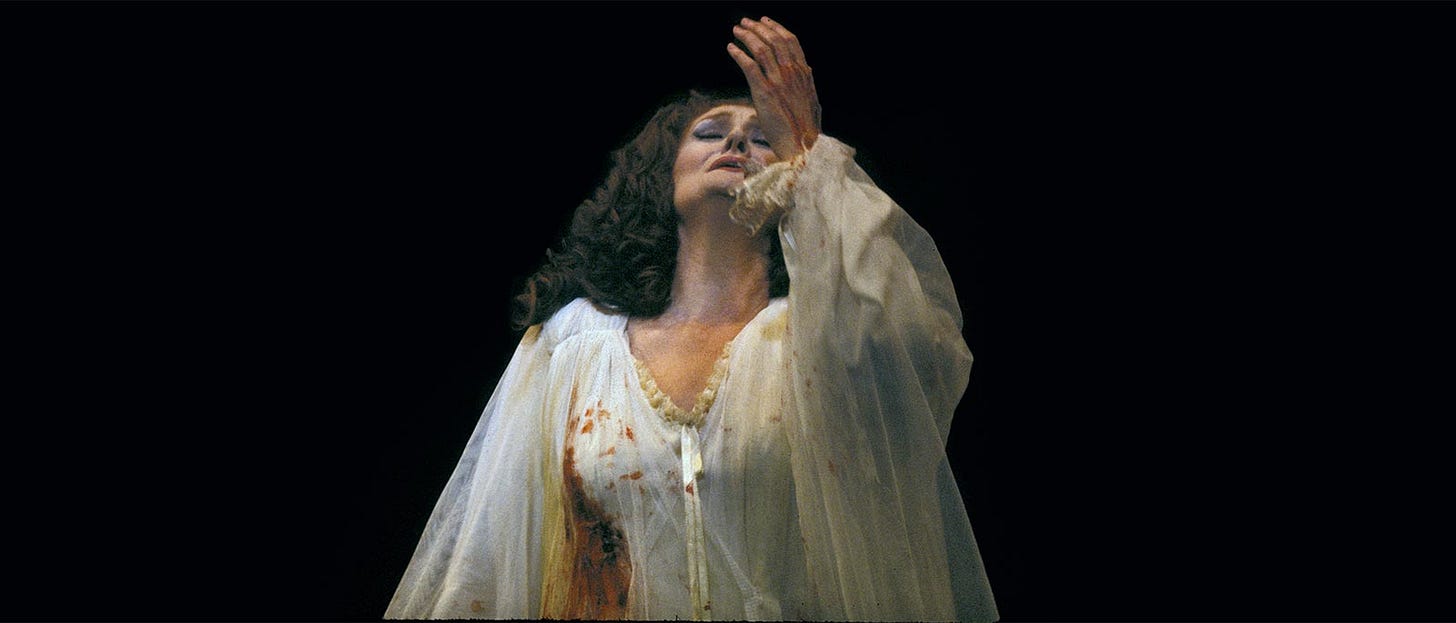Opera Daily 🎶 — Power in madness (who's mad and who gets to decide?)
"We all go a little mad sometimes...haven't you?"

Hello friends,
In Lucia’s mad scene, in Donizetti’s Italian opera Lucia di Lammermoor, Lucia hears the voice of her fiancé, but he’s not really there.
She hears it in her head.
But for her, she’s not mad. She’s in pain.
Soprano Natalie Dessay says that when you play a character; you don’t play the madness, you play something else.
You play the pain.
That there’s just one way to escape all the horror that is going on around you — to go to a place where nobody can touch you anymore, which is the madness.
In his review of Giovanni Paisiello’s 1789 opera Nina, o sia La Pazza per Amore (Nina, or the Girl Driven Mad by Love), Zachary Woolfe wrote something that made me uncomfortable when I initially read it, but that has left me intrigued:
Opera is madness. We love it because we love watching women fall apart mentally and physically because of the tension between female singers, who must be in total control, and their female characters, who keep losing control.
Madness traditionally was always tied to women, and the word hysteria came from hysteros “womb” in Greek.
I agree with singer-songwriter Nina Simone that an artist’s duty is to reflect the times, so it makes sense that the opera would reflect moments before feminism arose (and women would stop being diagnosed and treated incorrectly and often cruelly).
The “mad scene” is a staple of 19th-century operas, with composers Donizetti and Bellini leading the charge, representing pain and mental struggle through musical means.
In the 19th century, female characters tended to go mad, out of frustration and pain, usually with a solid 20 minutes of singing.
But in the 20th century, male characters went mad mostly out of some level of guilt, either for murder or other wrongdoings. Their mad scenes have less beautiful music and are often shorter, reflecting the musical formats and trends of the time.
Today we are going to listen to two famous mad scenes.
THE OPERA: Donizetti’s Lucia di Lammermoor
WHO GOES MAD: Lucia
WHAT LANGUAGE: Italian
VOICE TYPE: Soprano
DID SHE KILL ANYONE: Arturo, her new husband
AND THEN WHAT: She dies
THE OPERA: Benjamin Britten’s Peter Grimes
WHO GOES MAD: Peter Grimes
WHAT LANGUAGE: English
VOICE TYPE: Tenor
DID HE KILL ANYONE: Maybe
AND THEN WHAT: He takes his boat out and sinks it
Mad Scene, Donizetti’s Lucia di Lammermoor
Lucia is a young woman in love with a young man named Edgardo. And they want to marry. They have secretly met, exchanging rings and promising their loyalty to each other. But Lucia is forced by her brother to marry another man, Arturo Ravenswood (because an alliance with the Ravenswood family will strengthen their power and their landholdings). She knows it won't be that easy. Her role is to marry a prince and there is no expectation of love. The deal is property and power. She's just a product, an object.
In this scene, Lucia murders her arranged husband on their wedding night and, oblivious to what she has done, sings a love song to a different man. The vocal melody is accompanied by a glass harmonica (usually, a flute), suggesting a duet with the sweet and happy thoughts in her head.
🎧 Listening Example (13 minute listen): Soprano Joan Sutherland, the mad scene, from Donizetti's Lucia di Lammermoor in the Australian Opera's 1986 production at the Sydney Opera House.
🎧 Listening Example (4 minute listen): Soprano Natalie Dessay (Lucia), the mad scene from Donizetti's Lucia di Lammermoor, Conductor: James Levine, Production: Mary Zimmerman (clip taken from the 2007-08 live Opening Night)
Mad Scene, Benjamin Britten’s Peter Grimes
Peter Grimes is about a small fishing community on the East Coast of England. Peter Grimes (the title role sung by a tenor) is a fisherman, but the locals in the village see him as an outsider and don’t trust him.
While composer Benjamin Britten said he didn’t care for Vicker’s take on the role, his interpretation of the character of Peter Grimes was incredible. Many tenors have sung the title role in Peter Grimes, but Peter Pears (who performed in the premiere in 1945) and Jon Vickers are probably the most well-known for this incredibly complex character.
Britten was the master of creepy. In this scene, a mob of people from the town are searching for Grimes. He is breaking down, and the music reflects his sad state.
🎧 Listening Example (7 minute listen): Tenor Jon Vickers (in the title role), Act 3 of Peter Grimes. This Covent Garden Production, from 1981, also features Heather Harper as Ellen Orford and Norman Bailey as Balstrode, The Chorus and Orchestra of the Royal Opera, Covent Garden, are conducted by Sir Colin Davis.
Thank you for reading (and listening),
Michele
❤️ If you enjoyed this selection, hit the heart to like it. It helps others find Opera Daily.
📝A reminder that you can check out the complete Opera Daily archives and the playlist on YouTube for more selections. If you were forwarded this email by a friend, join us by subscribing:


Having seen that LUCIA w/Dessay at The Met; it was awful---Dessay made a brave effort but Zimmerman didn't know what she was doing. I heard Vickers last GRIMES at The Met and he was tremendous.
The first time I saw that scene by Dessay I had goosebumps and cried. I didn’t like Sutherland that much, not sure why. I adored, for a very long time, Callas in that role, I think that cd was stuck in my car player for years.
I think there is something cathartic in these madness scenes. When you are suffering, or even when you are only frustrated to the point that you want to shout, a good madness scene at top volume in your car, singing along as loud as you can, can do miracles!